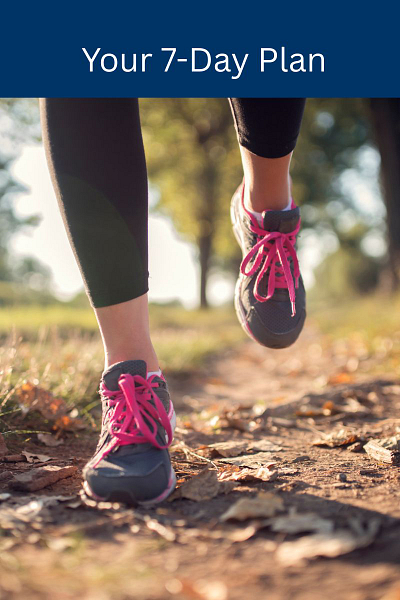How Exercise Boosts Longevity: The Power of Hormetic Stress for Aging Well
Discover how movement slows down the aging process
What if the right kind of stress could actually make you stronger, healthier, and biologically younger?
If you’ve been following along, you know we’ve been exploring the idea of good stress in this blog series. We started with an overview of hormesis and eustress—those beneficial stressors that challenge the body and mind just enough to spark repair, growth, and resilience. Then we took the plunge (literally) into saunas and cold exposure.
This week, we’re diving into what may be one of the most accessible, proven, and joyful forms of hormetic stress: exercise.
Don’t worry. This isn’t about gut-busting bootcamps or endless burpees. The kind of movement we’re talking about is movement that sparks energy, supports longevity, and brings joy. Done right, exercise becomes a powerful tool for aging more slowly, building resilience, and protecting your brain and bones.
What Happens When You Move: Hormetic Magic in Action
Exercise, when done right, is the ultimate good stressor. It puts just enough pressure on your system to trigger a cascade of positive responses:
🧬 Cellular Resilience:
It creates mild oxidative stress, which prompts your cells to repair and get stronger, making you more physically resilient.
🧠 Brain Protection:
It boosts brain-derived neurotrophic factor (BDNF), a key player in keeping your brain sharp, nimble, and youthful.
💪 Functional Strength:
It improves muscle strength and cardiovascular function, which are directly tied to your ability to stay independent as you age.
🦴 Structural Support:
For postmenopausal women especially, it plays a crucial role in protecting bone density and balance.
When you move your body, you’re sending a message to every cell: “Stay strong. Stay sharp. Stay in the game.”
The Cellular Power Boost You Didn't Know About
Did you know that one of exercise’s most remarkable effects is stimulating mitochondrial biogenesis? Simply by exercising your body, you’re creating brand new power plants inside your cells. That’s amazing, isn’t it?
Mitochondria are tiny structures inside nearly every cell that convert the food you eat into usable energy. Think of them as microscopic batteries that power everything your body does. As we age, we naturally lose mitochondria, and the ones we have become less efficient. It’s like having fewer and weaker batteries to power us through our lives.
While this process declines naturally with age, research shows that moderate exercise can reverse this trend by triggering your cells to make fresh, young mitochondria. Studies have found that just 12 weeks of consistent moderate exercise can increase mitochondrial content in muscle tissue by up to 40% in older adults. All you have to do is exercise to upgrade your body’s energy system to a younger, more efficient version!
Why This Matters More After 55 (Especially for Women)
Postmenopausal women experience changes in estrogen that affect muscle mass, bone density, fat distribution, and mood. Exercise is one of the most effective interventions we have to address these shifts.
Research shows:
📊 Resistance training can help reverse age-related muscle loss (sarcopenia) and improve insulin sensitivity.
📊 Weight-bearing activity reduces the risk of osteoporosis by improving bone density.
📊 Cardiovascular movement (like brisk walking or dancing) reduces the risk of dementia and improves mood.
Beyond the physical benefits, exercise after 55 becomes particularly crucial for neuroplasticity—your brain’s ability to form new connections.
A landmark study found that even moderate walking three times weekly increased hippocampal volume (a brain region critical for memory) in older adults, effectively adding years of cognitive resilience.
Translation? Hormetic stress from exercise can help our bodies stay younger as we age.
The Muscle-Brain Connection You Need To Know About
When you exercise, your muscles don’t just get stronger, they become communication centers. Working muscles release special proteins called myokines that travel throughout your body, positively influencing everything from brain health to inflammation levels.
Think of myokines as text messages your muscles send to other organs. When you move, these chemical messengers travel through your bloodstream, stimulating your brain, liver, heart, and immune system. They help improve brain sharpness, support metabolic health, and reduce inflammation, thereby triggering real biochemical changes that protect your body and mind.
One myokine, irisin, has been nicknamed the “exercise hormone” for its role in cognitive protection and metabolic health. Released during moderate activity, irisin appears to cross the blood-brain barrier and stimulate the production of proteins that support memory and learning. It’s as if your muscles are directly feeding your brain the nutrients it needs to stay young.
These molecular messengers help explain why consistent movement affects not just your physical strength but your mental clarity, mood, and immune function. Research shows that people who exercise regularly have stronger immune responses and better cognitive performance largely because of this muscle-to-organ communication network.
The Goldilocks Zone: Finding the Just-Right Amount
It may surprise you that more isn’t always better. In fact, too much intense exercise (especially without adequate recovery) can backfire, increasing inflammation and stress hormones. On the other hand, do too little and your muscles, bones, and brain coast into decline.
Hormesis lives in the “just right” zone—where challenge meets capacity and sparks growth.
Here are some hormetic sweet spots:
✨ Brisk walking for 30 minutes (even broken into smaller chunks).
✨ Strength training 2–3 times a week (bodyweight counts!).
✨ Gentle intervals, like walking hills or alternating pace on a stroll.
The goal isn’t to crush your workout; it’s to gently challenge your system and come back stronger.
Gentle HIIT Intervals for Real Life
You’ve probably heard of High Intensity Interval Training (HIIT), and maybe you’ve even felt a little dread at the thought of it. Images of sweat-drenched workouts that leave you gasping for air don’t bring to mind “joyful longevity.” But you don’t have to be breathless on the floor to reap the benefits.
HIIT involves short bursts of intense exercise where you’re breathing hard and it’s tough to chat, followed by rest or slower movement. For older adults, traditional HIIT exercises can feel jarring and even strain our joints.
That’s why gentle intervals are perfect: they give you similar benefits (like better heart health and energy) with less stress on your body. Gentle intervals involve short spurts of slightly harder effort followed by longer recovery. They boost cardiovascular health, insulin sensitivity, and mitochondrial function without overloading your system.
Compare gentle HIIT to Zone 2 cardio, such as brisk walking at a steady pace where you can still talk comfortably and keep going for longer periods. While both are hormetic stressors that spark resilience, incorporating gentle HIIT intervals boost the challenge and intensity, while Zone 2 builds endurance over time.
💡 Try this: Walk at a brisk pace for 30 seconds (fast enough to feel effort but not breathless; like you’re hurrying to catch a bus), then stroll for 2 minutes at a relaxed pace. Repeat 3–4 times. That’s it! A 10–15 minute walk with these gentle spikes in intensity once or twice a week creates a healthy hormetic response.
Do it outside, in nature, or with a friend—joy magnifies the benefits! For Zone 2 cardio, try a 20–30 minute brisk walk where you can chat but feel a light challenge. Mix both into your week for a balanced approach.
Muscle Is Your Metabolic Ally After 55
Muscle isn’t just about looking toned—it’s about staying independent, metabolically healthy, and injury-free. And after menopause, we naturally lose muscle faster unless we challenge it.
Strength training—using your own body weight, resistance bands, light dumbbells, or even household items—is a smart, safe, and scalable way to build muscle.
Try these functional moves:
🔹 Chair squats (sit to stand)
🔹 Wall push-up’s (or countertop push-ups)
🔹 Step-up’s (use a low stair)
🔹 Seated resistance band rows
All of these provide just enough challenge to stimulate muscle growth, improve balance, and fire up your metabolism.
What Gets in the Way—and How to Move Through It 🚶♀️
We all know that even with the best intentions, we can have trouble making exercise and movement a priority. Here are some common hurdles and how to reframe them:
“I don’t have time.” Try 5-minute “movement snacks” sprinkled throughout your day. They add up!
“I’m too tired.” Start with a gentle walk or stretch. Energy often follows action.
“I hate exercise.” Don’t call it exercise—dance in your kitchen or walk with a podcast. Make it fun!
“I’m out of shape.” Start where you are. Consistency beats intensity every time.
Also: keep it visible. Put your resistance bands by your desk. Keep walking shoes near the door. Little cues can spur you to action and make a big difference.
Your 7-Day Hormetic Movement Plan: Spark Vitality with Ease 🧬
Ready to embrace movement that strengthens your body and mind? This 7-day hormetic movement plan is designed for older adults, blending just enough challenge with plenty of recovery to boost resilience, energy, and longevity. Each day targets a specific aspect of health in a gentle, joyful way.
• Day 1: Strength Foundation – Build muscle and bone with simple moves like chair squats.
• Day 2: Mobility & Flexibility – Keep joints limber with gentle stretches and yoga moves to ease movement.
• Day 3: Gentle Intervals – Boost heart health with short, brisk intervals or Zone 2 cardio for energy.
• Day 4: Active Recovery – Support recovery with light walking and breathing.
• Day 5: Strength and Balance – Enhance stability with step-ups and planks.
• Day 6: Cardio and Coordination – Sharpen your brain-body connection with fun moves.
• Day 7: Full-Body Flow – Tie it all together with a relaxing flow for resilience.
Want the step-by-step plan with YouTube video guides? Upgrade to a paid subscription to download it at the end of this post and start moving with joy!
Frequently Asked Questions About Hormetic Exercise 💬
Can I do this if I have arthritis or joint pain?
Yes, but start gently and check with your doctor. Try seated moves like leg extensions or wall push-up’s to ease into it safely.
How much exercise do I need for anti-aging benefits?
20–30 minutes most days—like gentle intervals or Zone 2 cardio such as brisk walking—sparks cellular repair and boosts brain health. Consistency is key!
What if I’m new to exercise?
Start with 5-minute movement snacks like seated arm circles or a short walk around your home or office. Build slowly, and you’ll feel stronger in no time.
Do I need a gym or equipment?
Nope! Use your body weight, a chair, or water bottles for weights. The 7-day plan, with video demonstrations at the end of this post, keeps it simple.
How do I know I’m in the “just right” zone?
You should feel challenged but not drained. If you’re breathing harder but can talk, you’re golden.
Have more questions? Drop them in the comments, and let’s keep the conversation going!
Movement Is a Loving Act of Wellgevity
Exercise doesn’t have to be punishing to be powerful. In fact, for most of us, it shouldn’t be.
The science is clear: movement is medicine, especially the kind that creates hormetic stress. But beyond the compelling research, there’s something empowering about choosing a physical challenge that enhances our well-being. By embracing hormetic exercise and movement, we’re not just adding years to life—we’re adding vibrancy and life to those years.
So this week, I invite you to view exercise as a wonderful gift rather than a chore to check off your to do list: one that helps you live longer, feel better, and stay strong enough to do the things you love, for as long as possible.
Your body is wise. Give it just enough challenge, and it will rise.
“So let’s move, not to burn calories, but to burn brighter.”
Your Turn: What's your favorite “just enough” movement that brings both challenge and joy? Share in the comments below and let’s inspire each other to add life to our years!
Next week, we’ll explore another fascinating hormetic stress: intermittent fasting. Until then, remember that resilience isn’t about avoiding all stress; it’s about choosing the right kind.
📚 References:
Zhao, R., et al. (2020). Effect of Exercise Training on Bone Mineral Density in Postmenopausal Women: A Systematic Review and Meta-Analysis of Randomized Controlled Trials. Frontiers in Physiology, 11, 652.
Northey, J. M., et al. (2020). Effects of Exercise on Cognitive Performance in Older Adults: A Narrative Review. Journal of Clinical Medicine, 9(5), 1403.
Hood, D. A., Memme, J. M., Oliveira, A. N., & Triolo, M. (2019). Exercise is mitochondrial medicine for muscle. Journal of Clinical Investigation, 129(2), 373–383.
Weigert, C., Lehmann, R., & Hartwig, S. (2017). Skeletal Muscle as an Endocrine Organ: The Role of Myokines in Exercise Adaptations. Cold Spring Harbor Perspectives in Medicine, 7(11).
Erickson, K. I., Voss, M. W., Prakash, R. S., Basak, C., Szabo, A., Chaddock, L., Kim, J. S., Heo, S., Alves, H., White, S. M., Wojcicki, T. R., Mailey, E., Vieira, V. J., Martin, S. A., Pence, B. D., Woods, J. A., McAuley, E., & Kramer, A. F. (2011). Exercise training increases size of hippocampus and improves memory. Proceedings of the National Academy of Sciences, 108(7), 3017–3022.
Al-Sharman, A., Khalil, H., & Alghwiri, A. (2025). Walking and Hippocampal Formation Volume Changes: A Systematic Review. Brain Sciences January 2025.
Get Your 7-Day Hormetic Movement Plan 📋
Paid subscribers, here’s your download of the full 7-day hormetic movement plan to start building strength, resilience, and vitality today.
Not a paid subscriber? Upgrade now to unlock this step-by-step guide and support our community of vibrant movers!












I’m a life long athlete… and daily exerciser… so support your wise and healthy suggestions.